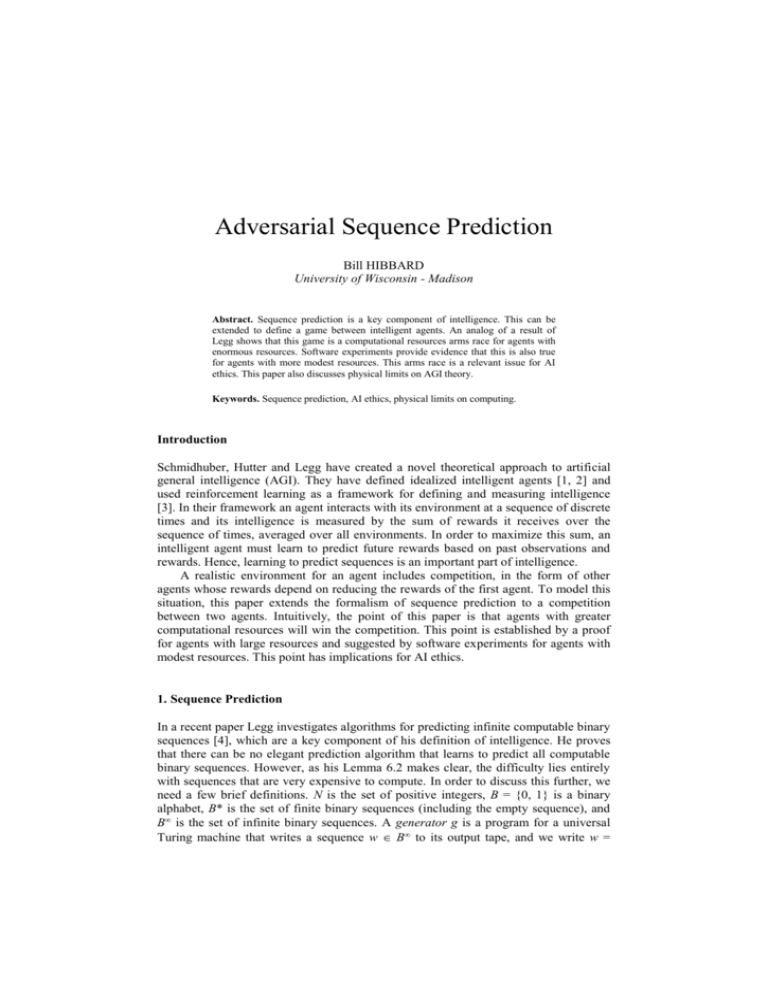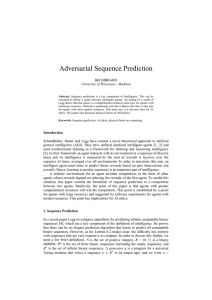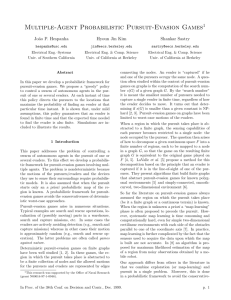hibbard_agi
advertisement

Adversarial Sequence Prediction
Bill HIBBARD
University of Wisconsin - Madison
Abstract. Sequence prediction is a key component of intelligence. This can be
extended to define a game between intelligent agents. An analog of a result of
Legg shows that this game is a computational resources arms race for agents with
enormous resources. Software experiments provide evidence that this is also true
for agents with more modest resources. This arms race is a relevant issue for AI
ethics. This paper also discusses physical limits on AGI theory.
Keywords. Sequence prediction, AI ethics, physical limits on computing.
Introduction
Schmidhuber, Hutter and Legg have created a novel theoretical approach to artificial
general intelligence (AGI). They have defined idealized intelligent agents [1, 2] and
used reinforcement learning as a framework for defining and measuring intelligence
[3]. In their framework an agent interacts with its environment at a sequence of discrete
times and its intelligence is measured by the sum of rewards it receives over the
sequence of times, averaged over all environments. In order to maximize this sum, an
intelligent agent must learn to predict future rewards based on past observations and
rewards. Hence, learning to predict sequences is an important part of intelligence.
A realistic environment for an agent includes competition, in the form of other
agents whose rewards depend on reducing the rewards of the first agent. To model this
situation, this paper extends the formalism of sequence prediction to a competition
between two agents. Intuitively, the point of this paper is that agents with greater
computational resources will win the competition. This point is established by a proof
for agents with large resources and suggested by software experiments for agents with
modest resources. This point has implications for AI ethics.
1. Sequence Prediction
In a recent paper Legg investigates algorithms for predicting infinite computable binary
sequences [4], which are a key component of his definition of intelligence. He proves
that there can be no elegant prediction algorithm that learns to predict all computable
binary sequences. However, as his Lemma 6.2 makes clear, the difficulty lies entirely
with sequences that are very expensive to compute. In order to discuss this further, we
need a few brief definitions. N is the set of positive integers, B = {0, 1} is a binary
alphabet, B* is the set of finite binary sequences (including the empty sequence), and
B is the set of infinite binary sequences. A generator g is a program for a universal
Turing machine that writes a sequence w B to its output tape, and we write w =
U(g). A predictor p is a program for a universal Turing machine that implements a total
function B* B. We say that a predictor p learns to predict a sequence x1 x2 x3 …
B if there exists r N such that n > r, p(x1 x2 x3 … xn) = xn+1. Let C B denote the
set of computable binary sequences computed by generators. Given a generator g such
that w = U(g), let tg(n) denote the number of computation steps performed by g before
the nth symbol of w is written.
Now, given any computable monotonically increasing function f: N N, define Cf
= {w C | g. U(g) = w and r N, n > r. tg(n) < f(n)}. Then Lemma 6.2 can be
stated as follows:
Paraphrase of Legg's Lemma 6.2. Given any computable monotonically
increasing function f: N N, there exists a predictor pf that learns to predict all
sequences in Cf. This is a bit different than Legg's statement of Lemma 6.2, but he does
prove this statement.
Lloyd estimates that the universe contains no more than 10 90 bits of information
and can have performed no more than 10120 elementary operations during its history
[5]. If we take the example of f(n) = 2n as Legg does, then for n > 400, f(n) is greater
than Lloyd's estimate for the number of computations performed in the history of the
universe. The laws of physics are not settled so Lloyd may be wrong, but there is no
evidence of infinite information processes in the universe. So in the physical world it is
reasonable to accept Lemma 6.2 as defining an elegant universal sequence predictor.
This predictor can learn to predict any sequence that can be generated in our universe.
But, as defined in the proof of Lemma 6.2, this elegant predictor requires too much
computing time to be implemented in our universe. So this still leaves open the
question of whether there exist sequence predictors efficient enough to be implemented
in this universe and that can learn to predict any sequence that can be generated in this
universe. It would be useful to have a mathematical definition of intelligence that
includes a physically realistic limit on computational resources, as advocated by Wang
[6].
2. Adversarial Sequence Prediction
One of the challenges for an intelligent mind in our world is competition from other
intelligent minds. The sequences that we must learn to predict are often generated by
minds that can observe our predictions and have an interest in preventing our accurate
prediction. In order to investigate this situation define an evader e and a predictor p as
programs for a universal Turing machine that implement total functions B* B. A
pair e and p play a game [7], where e produces a sequence x1 x2 x3 … B according to
xn+1 = e(y1 y2 y3 … yn) and p produces a sequence y1 y2 y3 … B according to yn+1 =
p(x1 x2 x3 … xn). The predictor p wins round n+1 if yn+1 = xn+1 and the evader e wins if
yn+1 xn+1. We say that the predictor p learns to predict the evader e if there exists
r N such that n > r, yn = xn and we say the evader e learns to evade the predictor p
if there exists r N such that n > r, yn xn.
Note that an evader whose sequence of output symbols is independent of the
prediction sequence is just a generator (the evader implements a function B* B but is
actually a program for a universal Turing machine that can write to its output tape
while ignoring symbols from its input tape). Hence any universal predictor for evaders
will also serve as a universal predictor for generators.
Also note the symmetry between evaders and predictors. Given a predictor p and
an evader e, define an evader e' by the program that implements p modified to
complement the binary symbols it writes to its output tape and define a predictor p' by
the program that implements e modified to complement the binary symbols it reads
from its input tape. Then p learns to predict e if and only if e' learns to evade p'.
Given any computable monotonically increasing function f: N N, define Ef = the
set of evaders e such that r N, n > r. te(n) < f(n) and define Pf = the set of
predictors p such that r N, n > r. tp(n) < f(n). We can prove the following analogy
to Legg's Lemma 6.2, for predictors and evaders.
Propostition 1. Given any computable monotonically increasing function f: N
N, there exists a predictor pf that learns to predict all evaders in Ef and there exists an
evader ef that learns to evade all predictors in Pf.
Proof. Construct a predictor pf as follows: Given an input sequence x1 x2 x3 … xn
and prediction history y1 y2 y3 … yn (this can either be remembered on a work tape by
the program implementing pf, or reconstructed by recursive invocations of pf on initial
subsequences of the input), run all evader programs of length n or less, using the
prediction history y1 y2 y3 … yn as input to those programs, each for f(n+1) steps or until
they've generated n+1 symbols. In a set Wn collect all generated sequences which
contain n+1 symbols and whose first n symbols match the input sequence x1 x2 x3 … xn.
Order the sequences in Wn according to a lexicographical ordering of the evader
programs that generated them. If Wn is empty, then return a prediction of 1. If Wn is not
empty, then return the n+1th symbol from the first sequence in the lexicographical
ordering.
Assume that pf plays the game with an evader e Ef whose program has length l,
and let r N be the value such that n > r. te(n) < f(n). Define m = max(l, r). Then for
all n > m the sequence generated by e will be in Wn. For each evader e' previous to e in
the lexicographical order ask if there exists r' max(m, length of program
implementing e') such that te'(r'+1) < f(r'+1), the output of e' matches the output of e for
the first r' symbols, and the output of e' does not match the output of e at the r'+1th
symbol. If this is the case then this e' may cause an error in the prediction of pf at the
r'+1th symbol, but e' cannot cause any errors for later symbols. If this is not the case for
e', then e' cannot cause any errors past the mth symbol. Define r" to be the maximum of
the r' values for all evaders e' previous to e in the lexicographical order for which such
r' exist (define r" = 1 if no such r' values exists). Define m' = max(m, r"+2). Then no e'
previous to e in the lexicographical order can cause any errors past m', so the presence
of e in Wn for n > m' means that pf will correctly predict the nth symbol for all n > m'.
That is, pf learns to predict e.
Now we can construct an evader ef using the program that implements pf modified
to complement the binary symbols it writes to its output tape. The proof that ef learns to
evade all predictors in Pf is the same as the proof that pf that learns to predict all
evaders in Ef, with the obvious interchange of roles for predictors and evaders.
This tells us that in the adversarial sequence prediction game, if either side has a
sufficient advantage in computational resources to simulate all possible opponents then
it can always win. So the game can be interpreted as a computational resources arms
race.
Note that a predictor or evader making truly random choices of its output symbols,
with 0 and 1 equally likely, will win half the rounds no matter what its opponent does.
But Proposition 1 tells us that an algorithm making pseudo-random choices will be
defeated by an opponent with a sufficient advantage in computing resources.
3. Software Experiments
Adversarial sequence prediction is a computational resources arms race for algorithms
using unrealistically large computational resources. Whether this is also true for
algorithms using more modest computational resources can best be determined by
software experiments. I have done this for a couple algorithms that use lookup tables to
learn their opponent's behavior. The size of the lookup tables is the measure of
computational resources. The predictor and evader start out with the same size lookup
tables (a parameter can override this) but as they win or lose at each round the sizes of
their lookup tables are increased or decreased. The software includes a parameter for
growth of total computing resources, to simulate non-zero-sum games. Occasional
random choices are inserted into the game, at a frequency controlled by a parameter, to
avoid repeating the same outcome in the experiments. The software for running these
experiments is available on-line [8].
Over a broad range of parameter values that define the specifics of these
experiments, one opponent eventually gets and keeps all the computing resources. Thus
these experiments provide evidence that adversarial sequence prediction is an unstable
computational resources arms race for reasonable levels of computational resources.
Interestingly, the game can be made stable, with neither opponent able to keep all
the resources, by increasing the frequency of random choices. It is natural and desirable
that simple table-lookup algorithms should be unable to predict the behavior of the
system's pseudo-random number algorithm. But more sophisticated algorithms could
learn to predict pseudo-random sequences.
The adversarial sequence prediction game would make an interesting way to
compare AGI implementations. Perhaps future AGI conferences could sponsor
competitions between the AGI systems of different researchers.
4. AI Ethics
Artificial intelligence (AI) is often depicted in science fiction stories and movies as a
threat to humans, and the issue of AI ethics has emerged as a serious subject [9, 10,
11]. Yudkowsky has proposed an effort to produce a design for AGI whose friendliness
toward humans can be proved as it evolves indefinitely into the future [12]. Legg's blog
includes a debate with Yudkowsky over whether such a proof is possible [13]. Legg
produced a proof that it is not possible to prove what an AI will be able to achieve in
the physical world, and Yudkowsky replied that he is not trying to prove what an AI
can achieve in the physical world but merely trying to prove that the AI maintains
friendly intentions as it evolves into the indefinite future. But intentions must be
implemented in the physical world, so proving any constraint on intentions requires
proving that the AI is able to achieve a constraint on the implementation of those
intentions in the physical world. That is, if you cannot prove that the AI will be able to
achieve a constraint on the physical world then you cannot prove that it will maintain a
constraint on its intentions.
Adversarial sequence prediction highlights a different sort of issue for AI ethics.
Rather than taking control from humans, AI threatens to give control to a small group
of humans. Financial markets, economic competition in general, warfare and politics
include variants of the adversarial sequence prediction game. One reasonable
explanation for the growing income inequality since the start of the information
economy is the unstable computational resources arms race associated with this game.
Particularly given that in the real world algorithm quality is often an important
computational resource. As the general intelligence of information systems increases,
we should expect increasing instability in the various adversarial sequence prediction
games in human society and consequent increases in economic and political inequality.
This will of course be a social problem, but will also provide an opportunity to generate
serious public interest in the issues of AI ethics.
References
[1]
[2]
[3]
[4]
[5]
[6]
[7]
[8]
[9]
[10]
[11]
[12]
[13]
J. Schmidhuber. The Speed Prior: A New Simplicity Measure Yielding Near-Optimal Computable
Predictions. In J. Kivinen and R. H. Sloan, editors, Proceedings of the 15th Annual Conference on
Computational Learning Theory (COLT 2002), Sydney, Australia, Lecture Notes in Artificial
Intelligence, pages 216--228. Springer, 2002. http://www.idsia.ch/~juergen/coltspeed/coltspeed.html
Hutter, M. Universal Artificial Intelligence: Sequential Decisions based on Algorithmic Probability.
Springer, Berlin, 2004. 300 pages. http://www.idsia.ch/~marcus/ai/uaibook.htm
Hutter, M. and S. Legg. Proc. A Formal Measure of Machine Intelligence. 15th Annual Machine
Learning Conference of Belgium and The Netherlands (Benelearn 2006), pages 73-80.
http://www.idsia.ch/idsiareport/IDSIA-10-06.pdf
Legg, S. Is there an Elegant Universal Theory of Prediction? Technical Report No. IDSIA-12-06.
October 19, 2006. IDSIA / USI-SUPSI Dalle Molle Institute for Artificial Intelligence. Galleria 2, 6928
Manno, Switzerland. http://www.idsia.ch/idsiareport/IDSIA-12-06.pdf
Lloyd, S. Computational Capacity of the Universe. Phys.Rev.Lett. 88 (2002) 237901.
http://arxiv.org/abs/quant-ph/0110141
Wang, P. Non-Axiomatic Reasoning System --- Exploring the essence of intelligence. PhD
Dissertation, Indiana University Comp. Sci. Dept. and the Cog. Sci. Program, 1995.
http://www.cogsci.indiana.edu/farg/peiwang/PUBLICATION/wang.thesis.ps
http://en.wikipedia.org/wiki/Game_theory
http://www.ssec.wisc.edu/~billh/g/asp.html
Hibbard, W. Super-Intelligent Machines. Computer Graphics 35(1), 11-13. 2001.
http://www.ssec.wisc.edu/~billh/visfiles.html
Bostrom, N. Ethical Issues in Advanced Artificial Intelligence. Cognitive, Emotive and Ethical Aspects
of Decision Making in Humans and in Artificial Intelligence, Vol. 2, ed. I. Smit et al., Int. Institute of
Advanced
Studies
in
Systems
Research
and
Cybernetics,
2003,
pp.
12-17.
http://www.nickbostrom.com/ethics/ai.html
Goertzel, B. Universal Ethics: The Foundations of Compassion in Pattern Dynamics. October 25, 2004.
http://www.goertzel.org/papers/UniversalEthics.htm
Yudkowsky, E. (2006) Knowability of FAI. http://sl4.org/wiki/KnowabilityOfFAI
Legg, S. Unprovability of Friendly AI. September 15, 2006. http://www.vetta.org/?p=6











